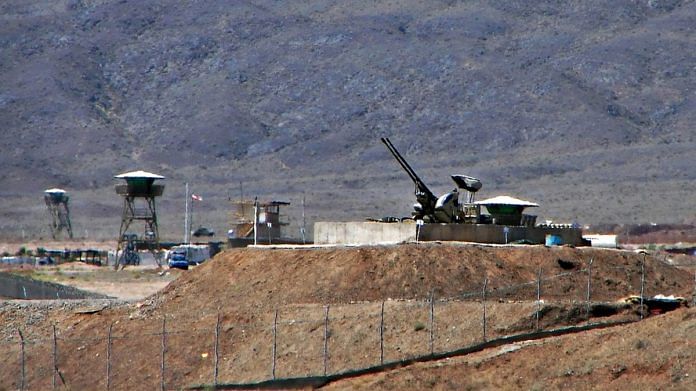The time difference between Operation Sindoor and Operation Midnight Hammer was 47 days. However, it took only a nano-second for India’s intrepid television news anchors and reporters to move from one to the other.
One moment, they’re pointing to the night sky over Pakistan lit up with drones fired by India, the next they’re describing the sky over Fordow in Iran, suddenly clouded by the rising smoke of American GBU- 57 “bunker buster” bombs.
One minute, TV anchors are asking us to admire the accuracy of the Rafale, the Sukhoi Su-30MKI, and Mirage 2000 fighter jets as the Indian Air Force “flattened” air bases in Pakistan; the next, we’re admiring the sleek precision of the US Air Force B-2 stealth bombers over Iran’s nuclear sites of Fordow, Natanz, and Isfahan – boom, boom.
Why, even the language is similar: In a flash, Indian news channels heralded Operation Sindoor: Remember Pakistan “chaknachoor” (ABP News)? Or for that matter, “Na bhoola, na chhoda. Ghar mein ghus ke maara” (Zee News)?
This week, for the United States’ Operation Midnight Hammer targeting Iranian nuclear sites, Times Now wrote, “Fury in motion.” “Full and final kar diya Iran ko?” asked TV9 Bharatvarsh, as the US entered Iranian air space for the first time and severely damaged the three sites.
“India strikes Pakistan,” said India Today. “India strikes Pakistan hard,” wrote Republic TV. “America attacks Iran,” said Aaj Tak. “US strikes Iran,” said CNN News 18.
Back in May, TV news had celebrated India’s air defence system consisting of the Russian S-400 missile system and the indigenously developed BrahMos missile—remember the visuals of Prime Minister Narendra Modi standing before the S-400 at Adampur airbase, after the ceasefire with Pakistan?
Since 13 June, when Israel launched its attacks on Iran and the latter responded with air strikes in Tel Aviv and at other places in Israel, Indian television has been marvelling at Israel’s ‘Iron Dome’ defence system—we’ve been treated to umpteen AI and computer-generated images of it, across news channels.
Also read: TV news is always enthusiastic about a ‘war’—India-Pakistan, Putin-Zelenskyy, Kannada-Tamil
Different war, same language
The similarities don’t end there. From the end of April, after the Pahalgam terror attack, Indian television reporters and anchors have been calling for war: In those first days of horror and outrage at the cold-blooded killing of 26 civilians, news anchors demanded war on Pakistan.
On TV 9, they’ve been in the ‘war zone’ ever since the Russia-Ukraine war began in 2022; on India TV, they’re still in the same ‘War room’ that they used for Operation Sindoor.
Reporters who had seized their protective clothing before rushing to Kashmir, Punjab, Gujarat, and Rajasthan when Pakistan retaliated with drone strikes in May, packed the same gear and landed in the Israeli capital of Tel Aviv in June.
Wearing helmets, India’s TV news reporters visited countless damaged buildings as Iran inflicted “largescale destruction on Israel” through drone attacks (CNN International).
They stood on the streets and relayed the latest developments while anchors in TV studios back home cautioned them to be “careful” — just as they had done when their reporters were in Kashmir during Operation Sindoor.
There were two major differences in the coverage, though: In Israel, India’s TV news reporters sheltered themselves in bunkers and turned into tour guides at the drop of a hat. Zee News reporter took us through ‘Shelter No. 421’ in Tel Aviv.
“It’s got quite a heavy door, which opens automatically. This place was first built in 1994, and has several rooms…” he said as he went down the stairs. The reporter showed us a toilet-kitchen (yes, they’re together) and a ‘hall’ space that could seat around 250 people.
Also read: No ceasefire in TV news studios. Anchors have sindoor running in their veins too
No expertise, just talking heads
The visuals we saw of what many news channels considered the beginning of World War III were pretty generic: satellite imagery of drones and bombs exploding on targets; maps and graphics; parts of Tehran or Tel Aviv and later Beersheba (Israel) going up in plumes of smoke. Channels embellished the coverage with flames licking the bottom of the TV screen and explosion sounds, martial music, which they called the “bugle” of war, or, as ABP News said, “the warning bell of World War III.”
Frankly, these images could have been from any war — and viewers would have been none the wiser.
In the studios, news anchors invited a steady stream of ‘defence’ or ‘strategic’ experts, many of whom had analysed Operation Sindoor. Many of the men you had never heard or seen before.
Leading the pack were a few usual suspects: Major General GD Bakshi (retd), Major General Sanjay Meston (retd), and former diplomat Deepak Vohra. Vohra appeared on so many news channels on the same day that it would seem he must have used a helicopter for transport.
There were plenty of retired army officers, many wearing their regimental caps. One analyst appeared in a fedora on India TV. All of them were described as ‘defence experts’ or ‘strategic analyst’ without disclosing the institute or organisation they are affiliated to.
Retired diplomats, who have been identified as former ambassadors, and a few professors were also called on shows.
The choices seem random; no one had any particular expertise, say, in West Asia or US affairs. They were just talking heads.
International commentators showed up on all English language news channels — with their designation and affiliation. There was Tom Cooper, a ‘military analyst’ based in Vienna, Austria, who appeared on both India Today and CNN News 18. Maxim Kuznetsov of the Russian Asian Business Council was on Republic TV. Also, New York-based Adrian Calamel of Arabian Peninsula Institute was on News X.
For television news channels, war reporting and commenting on war has become just another day on the job.
The author tweets @shailajabajpai. Views are personal.
(Edited by Prashant)






